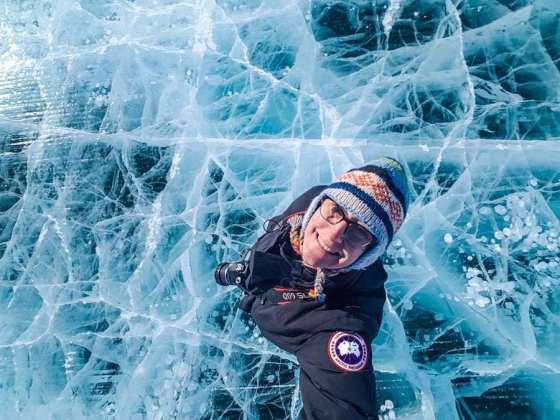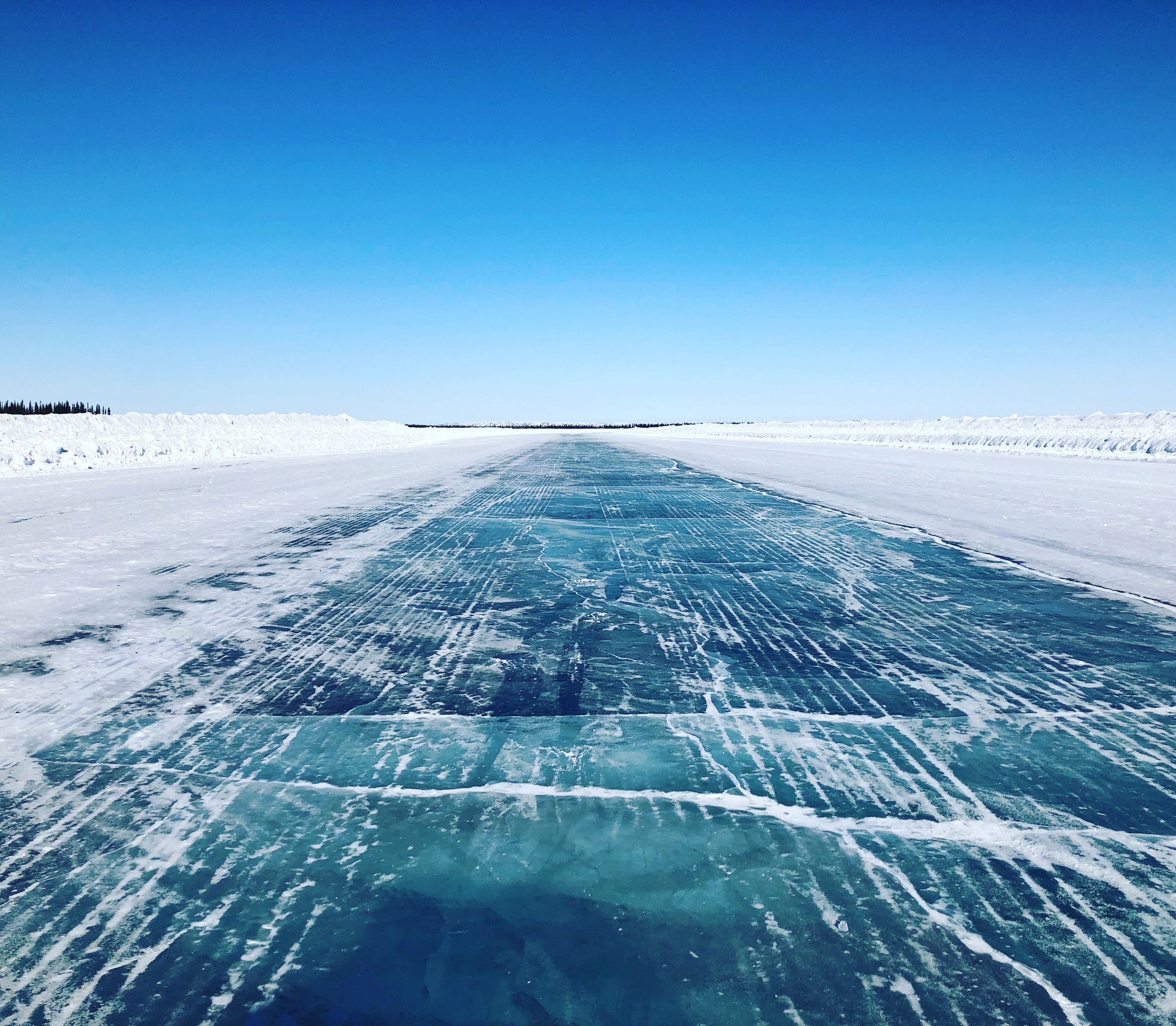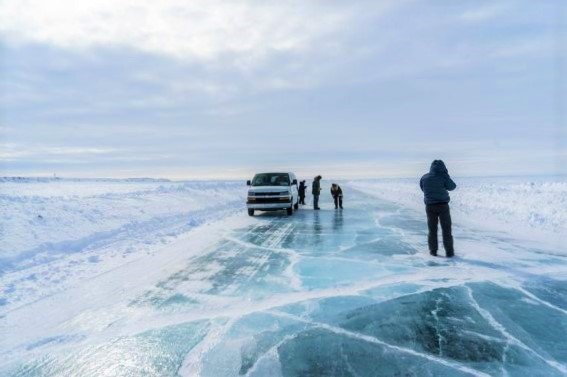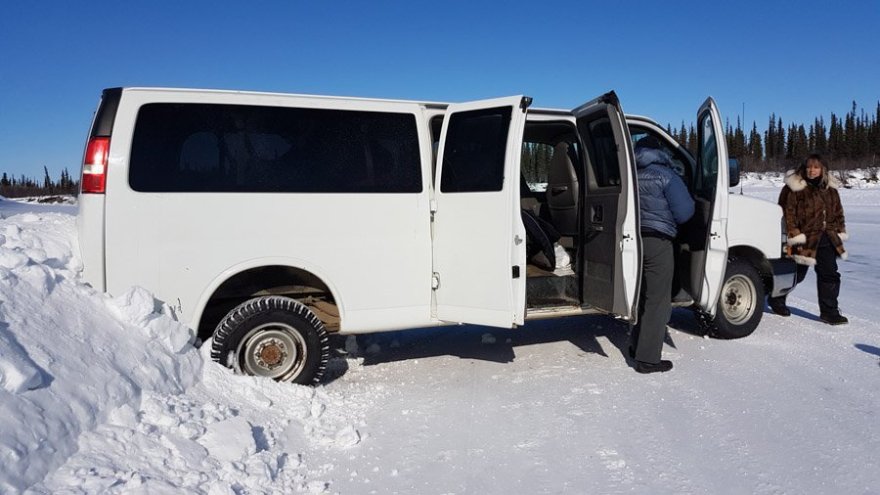
Driving Canada’s Ice Roads
Article and images by Sherry Ott originally appeared in Ottsworld.
“Wait, you’re telling me we are driving on the Arctic Ocean?” I exclaimed in disbelief as my stomach fluttered with butterflies. We had just gone to a whole new level in this winter adventure in the Canadian Arctic by driving on the Arctic Ocean on one of Canada’s ice roads.
It seemed so normal to be speeding down the road, the familiar rhythm of tires going over road seams lulling you into your sleepy place. But it wasn’t actually a road, it was ice. And the sound wasn’t driving over seams; it was cracks and abnormalities in the ice that created the rhythm. As long as I was driving on ice on one of Canada’s ice roads on the Arctic Ocean, there was no way I was getting lulled to sleep!
You would never know the ice beneath us would disappear in a month, melt into massive river tributaries filled with beluga whales. But that’s what made driving the Mackenzie Ice Road to Tuktoyaktuk so special; it was full of surprises and jaw dropping moments.

Credit: Tundra North Tours
Ice Roads – The Lifeline to the Arctic
It’s weird to think communities exist in extreme places and have no roads connecting them to the rest of the world. How do they survive? How do they get supplies, news from the outside, do they ever get visitors, and do they even know what a cronut is? Like all cultures, you adapt.
Tuktoyaktuk, Aklavik, and Inuvik in Canada’s Northwest Territories may not be connected by asphalt, but they do use the water and ice to stay connected. From May to October, the best form of transportation is a boat. From January to April, those same rivers and oceans freeze and roads are built on ice. The ice road system reaches out across the Northwest Territories to resupply communities and connect them to civilization.
For remote communities, the winter means freedom. They use the ice roads to get supplies, visit families, and reach larger communities. But for travellers seeking real experiences with the local Indigenous population, visiting during winter offers an incredibly unique adventure. Few people get to see the Arctic Ocean, let alone drive on it!

How the Coolest Road Around Works
The Mackenzie River Delta is the largest and longest river system in Canada, and it’s the 2nd largest river delta in North America next to the Mississippi Delta. The Mackenzie River is a winding water-world in the summer. But as the dark winter arrives, the river freezes and becomes the main mode of transportation in the region.
Inuvik, the largest community in the region, is connected to Aklavik via the frozen river and to Tuktoyaktuk via the river and the Arctic Ocean.

The Canadian government makes and maintains the ice road every fall by clearing off the snow, and checking ice thickness for safety. To ensure that the roads are safe, road crews now use ground-penetrating radar to check the ice’s exact thickness. They also put up signs and maintain the road during the months it’s open.

I’ll Take That on Ice
I braced myself as I felt the van lose control and start sliding on the ice. Everything suddenly switched into slow motion; I saw the landscape around me spin around. I didn’t scream, I didn’t say a word. I held my breath. It all happened really fast as we rounded a gentle bend on the frozen river. Suddenly the tires lost their grip, the van did a full 360 spin and the back end landed in a big snow bank with a thud. We were all fine thanks to the low speeds of the road, but it was going to take a little muscle to get the van out.
We were driving the ice road in April with only a few weeks left until the road would be closed. Normally the ice is dry and cold all winter creating a lot of friction for the tires. In the spring, however, late afternoon sun is out and the temps are a little warmer. This melts the ice under the tires, reducing friction, and spin-outs are more likely.
Luckily we had shovels, radios, and cell phones that we used as we dug our van out of the drift. Also, local people stopped to help. It was a great way to see the community in action.

Ice roads aren’t any more dangerous than regular roads. The ice roads are maintained just like any other roads. A speed limit is enforced. You don’t need tire chains or a special type of car to drive the road, but you do need to be smart and prepared. Vehicles should have shovels, food, blankets, and communication tools at all times.
You can easily stop anywhere along the road to get out and experience the ice road up close. This was my favorite part. When I first set foot outside the van I felt dizzy as I looked at the ice underneath my boots. It was all cracked and appeared like a deep blue marble; not something you really want to see when you are walking on ice! I swear I even heard it creak and moan as I took steps on it. Through the winter, cracks in the ice are created by the expansion and contraction of the surface ice due to variations in temperature. Walking on the marbled ice seems dangerous, but it’s safe as the ice is still very thick. You’ll also see little round markings in the ice which are frozen bubbles that never made it to the surface before freezing.

What Makes Driving the Ice Road Such A Great Arctic Adventure?
I like adventures that are in short supply, and like most things, ice roads won’t be here forever. In fact, at the time of this writing, the Inuvik to Tuktoyaktuk ice road has been officially closed. I was able to drive on it in the last year of its existence.
In the summer of 2017 a new highway was opened to connect Inuvik and Tuktoyaktuk any time of year. The ice road will no longer be created or maintained in the winter. The creation of the new road means you can drive the Dempster Highway all the way to the Arctic Ocean for the first time in Canada.
It’s Canada’s first road to the Arctic Ocean!
Climate change means ice roads have been freezing later and melting earlier, drastically reducing the window of time isolated residents can use the roads and tourists can enjoy them.
Russell Neudorf, the former deputy minister of transportation notes “The ice road season is getting shorter for us. That’s because we’re getting warmer weather throughout the year. Fifteen or twenty years ago, we noticed something changing and it continues to change. It continues to get warmer.”
However, you can still drive an ice road from Inuvik to Aklavik. Tundra North Tours will continue to offer ice road trips to Aklavik as part of its winter adventure offerings. If you are looking for a truly unique adventure, then go north in winter and experience an ice road. And while you are there, check out all of the other Arctic adventure tours you can do! And don’t wait too long, the ice roads are an arctic tradition that may be slowly going by the wayside.
